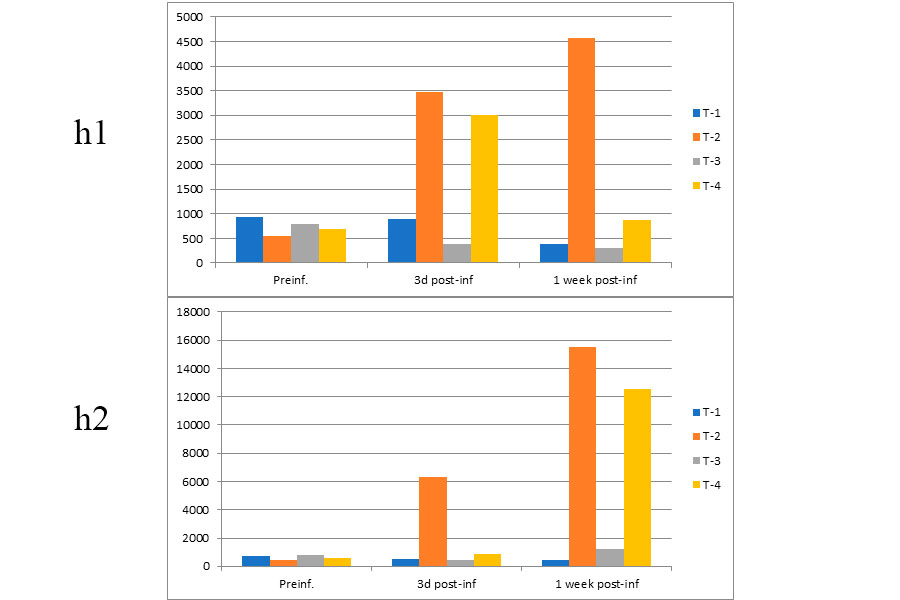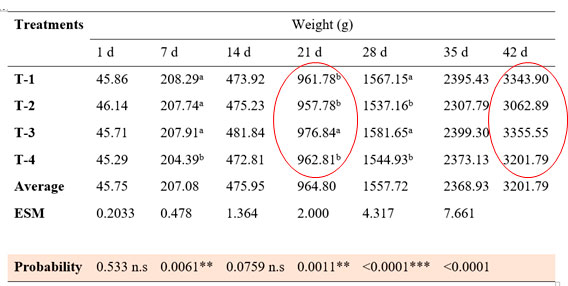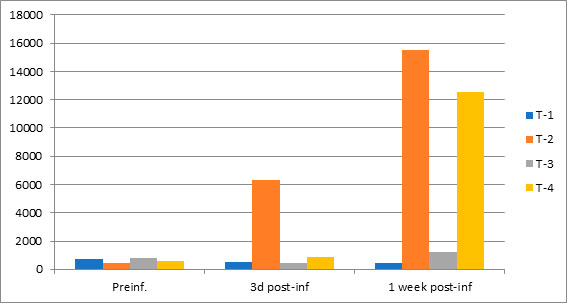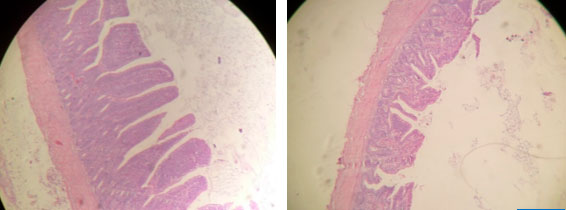Effect of Alquermold Natural in broilers challenged with Clostridium perfringens

Photo:
* h.1. Analysis of CFU of Clostridium sulphite-reductants in the duodenum in the different stages of the trial: preinfection, 3 days post-infection and 1-week post-infection.
* h.2. Analysis of CFU of Clostridium sulphite-reductants in the cecum in the different stages of the trial: preinfection, 3 days post-infection and 1-week post-infection.
OBJECTIVE
In an in vivo trial carried out in an experimental farm of Universidad Científica del Sur (Científica) or Scientific University of the South (Lima-Peru) in September of 2017, bactericidal effects of a product Alquermold Natural, a natural preservative with cimenol ring on productive parameters and CFU count in duodenum and cecum, in broilers challenged with Clostridium perfringens (C. perfringens artificial infection), were analyzed.
MATERIAL AND METHODS
This trial involved a total of 504 Cobb 500 broilers distributed in 4 batch or treatments (126 animals/batch) through a Completely Randomized Design (CRD) protocol. Each batch had seven replicates, so there was a total of 28 experimental units with 18 broilers each. The trial was carried out from birth until sacrifice, a total of 42 days.
Batches were as indicated below:
- T-1 (negative control): Standard basal diet (BD).
- T-2 (positive control): BD + Challenge with C. perfringens in drinking water at days 19, 20 and 21 of age with 108 CFU/broiler.
- T-3 (natural preservative with cimenol ring as preventive): BD + Natural preservative at 0.5 kg/Tm + Challenge with C. perfringens in drinking water at days 19, 20 and 21 of age with 108 CFU/broiler.
- T-4 (natural preservative with cimenol ring as treatment): BD + Challenge with C. perfringens in drinking water at days 19, 20 and 21 of age with 108 CFU/broiler + Inclusion of 1 ml of natural preservative per litter of drinking water for 7 days from the detection of signs of necrotic enteritis.
For data processing and analysis, tests of normality, homogeneity of variance, ANOVA and a Tukey comparison test were carried out. The General Linear Model (GLM) procedure of SAS, version 9.1 (SAS Institute, 2003) was used.
RESULTS
a) Broilers weights by stage:

Chart 1: Effect of natural preservative with cimenol ring as a preventive and treatment on weight (g) of broilers from 1 to 42 days of age challenged with C. perfringens (T-1: Control / T-2: Control + Challenge / T-3: Cimenol ring (prevention) + Challenge/ T-4: Challenge + Cimenol ring (treatment post signs).
b) Weight gain:
Effect of Alquermold Natural as a preventive and treatment on the weight gain (g/animal/d) of broilers from 1 to 42 days of age challenged with Clostridium perfringens.

Chart 2: Effect of natural preservative with cimenol ring as a preventive and treatment on weight gain (g/animal/d) of broilers from 1 to 42 days of age challenged with C. perfringens (T-1: Control / T-2: Control + Challenge / T-3: Cimenol ring (prevention) + Challenge/ T-4: Challenge + Cimenol ring (treatment post signs).
c) Feed consumption:

Chart 3: Effect of natural preservative with cimenol ring as a preventive and treatment on feed intake (g/animal/d) of broilers from 1 to 42 days of age challenged with C. perfringens (T-1: Control / T-2: Control + Challenge / T-3: Cimenol ring (prevention) + Challenge / T-4: Challenge + Cimenol ring (treatment post signs).
d) Feed Conversion Rate (FCR):

Chart 4: Effect of natural preservative with cimenol ring as a preventive and treatment on feed conversion rate (g/animal/d) of broilers from 1 to 42 days of age challenged with C. perfringens (T-1: Control / T-2: Control + Challenge / T-3: Cimenol ring (prevention) + Challenge/ T-4: Challenge + Cimenol ring (treatment post signs).
e) Mortality:

Chart 5: Effect of natural preservative with cimenol ring as a preventive and treatment on mortality (%) of broilers from 1 to 42 days of age challenged with C. perfringens (T-1: Control / T-2: Control + Challenge / T-3: Cimenol ring (prevention) + Challenge/ T-4: Challenge + Cimenol ring (treatment post signs).
f) Uniformity:
Uniformity indicates weight similarity between broilers of the same batch. Birds were weighed individually during the trial.

Chart 6: Effect of the natural preservative with cimenol ring as a preventive and treatment on uniformity of broilers from 1 to 42 days of age challenged with C. perfringens (T-1: Control / T-2: Control + Challenge / T-3: Cimenol ring (prevention) + Challenge/ T-4: Challenge + Cimenol ring (treatment post signs).
g) Carcass yield:
As seen in the chart below, T-3 batch obtained the best carcass weight. In addition, people responsible for the trial indicated that broilers of this batch had remarkably lower percentage of abdominal fat.

Chart 7: Effect of the natural preservative with cimenol ring as a preventive and treatment on carcass yield of broilers from 1 to 42 days of age challenged with C. perfringens (T-1: Control / T-2: Control + Challenge / T-3: Cimenol ring (prevention) + Challenge/ T-4: Challenge + Cimenol ring (treatment post signs).
h) Microbiological analysis:
Chart 8: Analysis of sulphite-reducing Clostridium in duodenum performed previously to the infection, 3 days post-infection and 1-week post-infection (T-1: Control / T-2: Control + Challenge / T-3: Cimenol ring (prevention) + Challenge/ T-4: Challenge + Cimenol ring (treatment post signs).

Chart 9: Analysis of sulphite-reducing Clostridium in cecum performed previously to the infection, 3 days post-infection and 1-week post-infection (T-1: Control / T-2: Control + Challenge / T-3: Cimenol ring (prevention) + Challenge/ T-4: Challenge + Cimenol ring (treatment post signs).

i) Histopathology
In duodenum, as well as in the other parts of the intestine (jejunum, ileum, ceca and colon), T3 batch (preservative as preventive) had less number of samples with lesions than batches T2 (infected non-treated) and T4 (preservative as treatment). Furthermore, lesions in batches treated with natural preservative where less severe than in T2 batch, because while T2 showed atrophy and necrosis, T3 and T4 batches had mild atrophy and mucus. Lesions found are described in the next pictures.
Chart 10: Number of samples with lesions compatible to necrotic enteritis when performing histopathology of the duodenum (T-1: Control / T-2: Control + Challenge / T-3: Cimenol ring (prevention) + Challenge/ T-4: Challenge + Cimenol ring (treatment post signs).


Left: Normal duodenal mucosa obtained by histopathology of batch T1 (control).
Right: Regenerative hyperplasia in duodenal mucosa of batch T2 (control + challenge).

Left: Normal jejunum appearance showed in batch T3 (preservative as preventive)
Right: Atrophied jejunum present in batch T2 (control + challenge)
Left:: Normal contracted ceca (batch T3 – preservative as preventive).
Right Atrophied and extended ceca (batch T2 – control + challenge)

Left:: Normal colon (batch T3 – preservative as preventive)
Right: Mild atrophy seen in batch T4 (preservative as treatment)
j) Intestinal morphometry
A longer mucosal length is related to higher surface of absorption and, therefore, greater utilisation of the diet.
Chart 11: Intestinal morphometry at 1-week post-challenge (T-1: Control / T-2: Control + Challenge / T-3: Cimenol ring (prevention) + Challenge/ T-4: Challenge + Cimenol ring (treatment post signs).

CONCLUSIONS
1) Productive parameters (weight, feed conversion rate, mortality)
- In T1 batch (control), normal productive parameters were observed.
- There was a great decrease in productive parameters in T2 batch after being challenged with C. perfringens.
- T3 batch (natural preservative as preventive) significantly and numerically increased live weight, weight gain and feed consumption and decreased feed conversion rate. T4 batch (natural preservative as treatment) improved productive parameters but did not reach T3 batch results.
- Mortality was the lowest in T3 batch (natural preservative as a preventive). In batch T4 (natural preservative as treatment) it was lower than in T2 (infected non-treated).
- After challenge with C. perfringens, T3 animals (natural preservative as prevention) did not change their productive parameters:
- T3 broilers weighed 292 grams more at 42 days of life compared to T2 (infected non-treated)
- T3 broilers improved the conversion index by 12.3%, compared to T2 (infected non-treated)
- After challenged with Clostridium perfringens, T4 broilers, which received natural preservative in drinking water as treatment, improved their weight gain / bird / day.
- T4 broilers weighed 138,9 grams more at 42 days of life compared to T2 broilers (infected non-treated).
- T4 broilers improved their feed conversion rate by 8,7% compared to T2 broilers (infected).

-
Chart 11: Differences in productive parameters between challenged batches.
2) Uniformity
Treatment and prevention with natural preservative (T-3 and T-4 batches) obtained higher uniformity of broilers than the 80% observed in the control batch (T1), reaching 86% uniformity in the case of the T3 batch (preservative as preventive).
3) Carcass yield
Birds in T-3 batch had the highest carcass yield and the lowest % of abdominal fat, while T-4 did not reach normal carcass yield.
4) Microbiological analysis (Sulphite-reducing Clostridium)
T-3 batch had the lowest UFC count in duodenum and cecum post-infection. Treatment with natural preservative (batch T-4) reduced the UFC count in duodenum and cecum compared to batch T2 (infected non-treated).
5) Histopathology
- T2 batch (infected non-treated) had more animals that presented necrotic enteritis lesions, and these lesions were more severe than in other batches, including atrophy, necrosis and ulcers.
- T3 and T4 batches (using natural preservative) had less lesions and these lesions were milder than batch T2 (infected non-treated).
- T3 batch (preservative as preventive) was the one with the lowest number of lesions and these were the mildest.
6) Intestinal morphometry
- Mucosal length was the shortest in T2 batch (infected).
- T3 batch (preservative as preventive) had the longest length, being even longer than mucosa of the control batch (T1).
RECOMMENDATIONS
1) Natural preservative with cimenol ring can be used to prevent necrotic enteritis, with great results.
2) Natural preservative with cimenol ring can be used as a treatment for necrotic enteritis when an outbreak is taking place.
3) Natural preservative with cimenol ring works better as prevention of necrotic enteritis than as treatment.
The natural preservative with cimenol ring is commercialized as Alquermold Natural, developed by Biovet S.A. Laboratorios, composed of cimenol ring and citric acid. It controls the pathogenic intestinal flora and works as a natural preservative of raw materials and feed. It is effective at low doses, with proved immediate and long-term efficacy, so it represents an alternative to organic acids.
